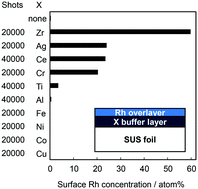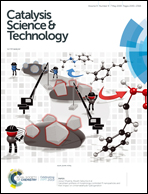Thermal stabilisation effects of Zr buffer layer on nanometric Rh overlayer catalyst formed on metal foil substrate†
Abstract
A nanometric Rh overlayer formed on a metal foil substrate enables much higher turnover frequencies in NO reduction than the Rh nanoparticles used in conventional three-way catalysis. However, the thermal stability of the Rh overlayer structure needs to be improved for practical applications. In the present study, a Zr buffer layer inserted between the Rh overlayer and the foil substrate efficiently overcame the thermal deterioration at 900 °C for 25 h. A honeycomb catalyst consisting of a 7 nm-thick Rh overlayer, a 500 nm-thick Zr buffer layer and a 30 μm-thick Fe–Cr–Al metal (SUS) foil was prepared by pulsed arc-plasma deposition. After thermal ageing, the Rh/Zr/SUS demonstrated steep light-off characteristics in simulated NO–CO–C3H6–O2 reactions. In contrast, the neat catalyst without the buffer layer (Rh/SUS) was totally deactivated by the Al2O3 passivation layer that formed over the active Rh overlayer. The Zr buffer layer preserves the outermost surface of the Rh overlayer by blocking the interaction between the Rh and Al2O3 layers. Consequently, the Rh surface coverage of Rh/Zr/SUS exceeded 80% after thermal ageing at 900 °C, versus almost 0% for Rh/SUS.



 Please wait while we load your content...
Please wait while we load your content...